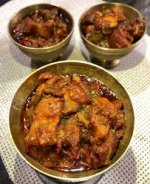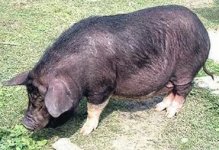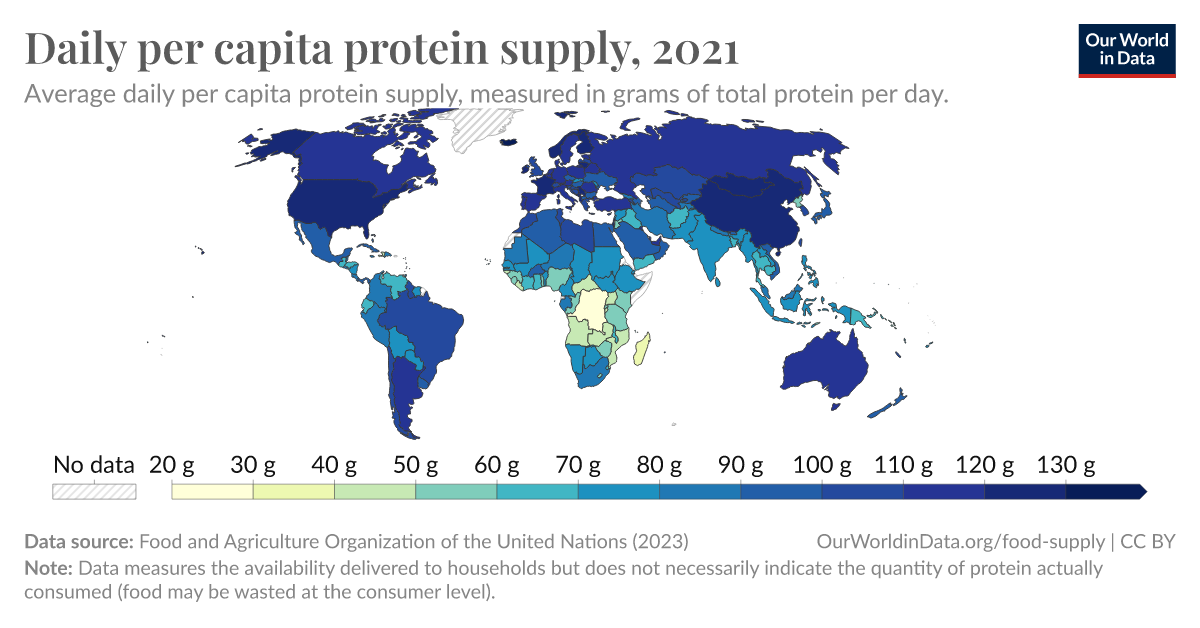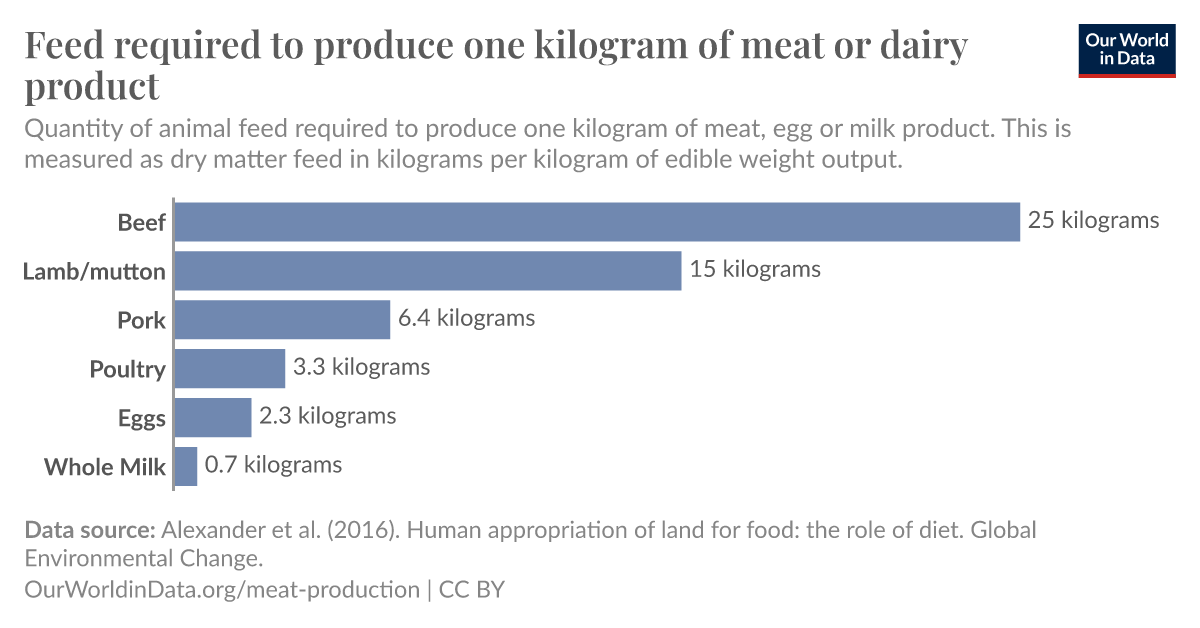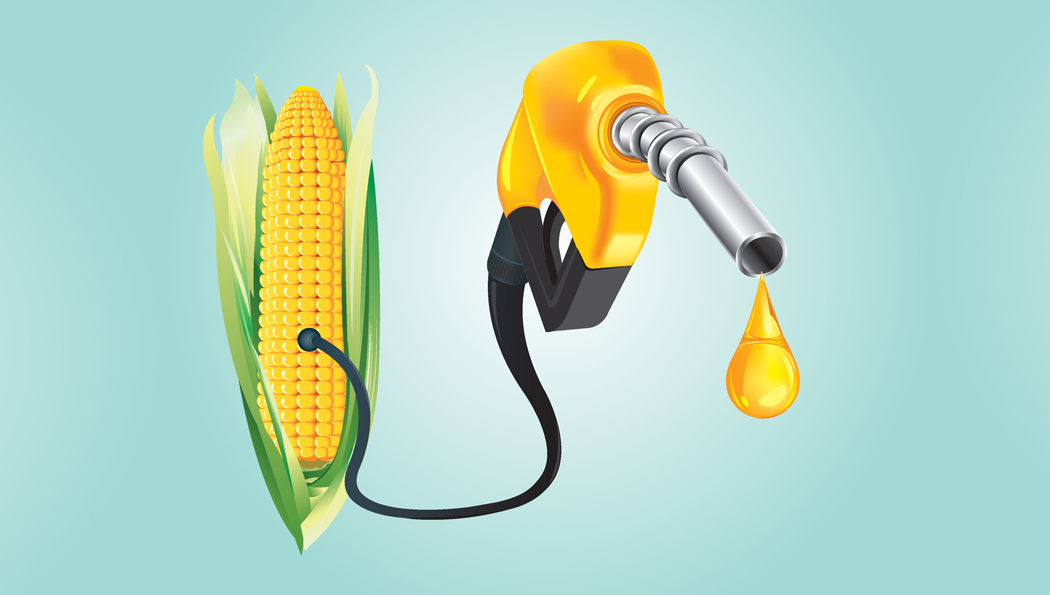For meat and protein per capita:
Its about 6 - 7 kg for India per capita (per year) right now (from FAO database).
So like I said earlier about 9-10 times less than China.
Basically 6.5 kg is about 6500/365 = 18 gm meat per day
maybe about 18 x 0.25 = 5 gm protein from meat per day
Supply is about 70 gm protein per day. So 65 gm is from non-meat basically.
5/70 = 7%
56 kg for China is about = 150 gm meat per day.
About 150 x0.25 = 37 gm meat per day.
Supply for China is about 125 gm protein per day.
37/125 = 30%
protein map:
Average daily per capita protein supply, measured in grams of total protein per day.

ourworldindata.org
India from 1960 to present:
Average daily per capita protein supply, measured in grams of total protein per day.

ourworldindata.org
From 2005 to 2021, increase from 52 to 70.5 g per capita (after stalling at 50 g level since 1960s till mid 2000s)
So its very likely the growth continues at same pace or better to 80 g and then 90g (for this decade and next), lets see.
China is country to learn from and emulate for animal protein growth from earlier "cold war" base level (40 - 50 gm) and economic development rise (going through 60gm, 70gm then 80g and 90g to current 120 gm):
China from 1960 to present:
Average daily per capita protein supply, measured in grams of total protein per day.

ourworldindata.org
For India, compared to pork..... poultry and eggs is where the existing expertise can be harnessed for animal protein growth...i.e good return on investment compared to starting and operating costs of rest....and their lower grain demands etc:
Quantity of animal feed required to produce one kilogram of meat, egg or milk product. This is measured as dry matter feed in kilograms per kilogram of edible weight output.

ourworldindata.org
India has vast resource of livestock and poultry, which play a vital role in improving the socio-eco
pib.gov.in
"Egg production in the country has increased from 78.48 billion in 2014-15 to 129.60 billion Nos. in 2021-22. Egg production in the country is growing at the rate (CAGR) of 7.4% per annum. The per capita availability of egg is at 95 eggs per annum in 2021-22."
"Meat production in the country has increased from 6.69 million tonnes in 2014-15 to 9.29 million tonnes in 2021-22."
In fiscal year 2023, the production of eggs across India amounted to over 138 billion, a significant increase from about 16 billion eggs produced in fiscal year 1986.

www.statista.com
Poultry:
Fish is another one with optimal return:
Opinion: Saurabh Bandyopadhyay, Laxmi Joshi and Nijara Deka. Fish contributes to ensuring domestic food and nutritional security and India registered a per capita yearly consumption of over 13 kg in 2022-23. In addition, more varieties of fish are available for consumption by households through...
www.ncaer.org
Fish contributes to ensuring domestic food and nutritional security and India registered a per capita yearly consumption of over 13 kg in 2022-23.
(Basically a doubling over 10 years from 6 kg per capita per year then)
The total consumption according to this now stands as nearing 20 million tons per year now (rather than 15 I mentioned earlier).
======================
As for Alcohol:

en.wikipedia.org
Both countries are around 5-6 liters per person per year right now.
Indian alcohols may lean more towards using stuff like palm + coconut tree sap (toddy/palm wine) and sugar cane (rum but known as whiskey locally too) and wine from grapes etc too are becoming popular.
Compared to grain alcohols that you mention (though there are Indian grain alcohols, both whiskey, clear spirit etc)....again maybe reducing grain footprint of Indian alcohol compared to Chinese alcohol trends (baijiu, beer heavy etc)...at least what is made locally anyway.
Lot of alcohol is also imported, so those grain footprints are essentially outsourced to foreign countries.
There is also the bio ethanol production and its grain footprint.
i.e how much bioethanol you produce and then the corn and grain vs sugar cane (not grain) you use.
"1 bushel of corn (56 pounds) = 2.8 gallons of ethanol"
Did you know 33% of Ontario’s harvested grain corn is used to make ethanol? What is ethanol? Ethanol is a…

goodineverygrain.ca

en.wikipedia.org
If my numbers are right, about 8 kg pure ethanol can be produced from 25kg of corn.
i.e about 3:1 conversion.
Regarding pure grain to meat
The "best case" ratios I found are (grain input to meat output):
Beef: 3:1 (but high requirement on grass etc past this, i.e another 3:1 or more added)
Pork: 4:1 (but can be done exclusively)
Chicken, Eggs etc: 2:1
These all are about x0.25 to get final protein (egg is about half of meat and fish).
So you can see these add grain intensity compared to grain consumption by humans directly for protein (or protein concentrated crops like legumes, lentils or dairy concentrated cheese/yoghurt etc, if latter is done with minimal grain).
Anyway this is all part of reason I think India best bet to increase for next cpl decades animal protein wise are: chicken, eggs, dairy, fish.
More info here:

en.wikipedia.org


